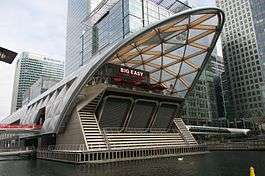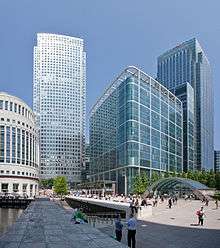Canary Wharf railway station
| Canary Wharf | |
|---|---|
 Above-water section of the station known as Crossrail Place | |
 Canary Wharf Location of Canary Wharf in Greater London | |
| Location | West India Quay, Canary Wharf |
| Local authority | London Borough of Tower Hamlets |
| Managed by | MTR Corporation (Crossrail) Ltd |
| Owner | Transport for London |
| Number of platforms | 2 |
| Fare zone | 2 |
| OSI |
Canary Wharf West India Quay |
| Key dates | |
| Autumn 2019 | Expected opening |
| Other information | |
| Lists of stations | |
| WGS84 | 51°30′22″N 0°00′57″W / 51.5061°N 0.01578°WCoordinates: 51°30′22″N 0°00′57″W / 51.5061°N 0.01578°W |
|
| |
Canary Wharf is a future railway station in Canary Wharf, East London. The station forms an artificial island in the West India Docks (North Dock) and is also a bridge between Canary Wharf and Poplar to the north. The five upper levels of the station are a mixed-use development known as Crossrail Place.[1] It will be on the Abbey Wood branch of the Crossrail route between Whitechapel and Custom House. Construction began in May 2009, and it was expected to start receiving passenger rail services in 2018, but is now planned to open in autumn 2019. During the project's development the station was named Isle of Dogs, before the current name was adopted.[2] Construction will cost an estimated £500 million to complete.[3]
The station will be one of the largest on the Crossrail route when it opens, providing Canary Wharf estate with a connection to the National Rail network and additionally an interchange with Canary Wharf station on the London Underground and Poplar DLR station on the Docklands Light Railway.
Design and construction
The station is located beneath and within the West India North Dock.[4] The station will extend from east of the Docklands Light Railway bridge to the east end of the dock. It stands within a 475-metre (1,558 ft) long concrete box with a 245-metre (804 ft) long island platform. It is fitted out to 210 m (690 ft) with the potential for extension should the need to operate longer trains arise. A 165-metre (541 ft) long scissor crossover at the western end of the station will enable trains to either terminate at Canary Wharf and turn back towards central London, or to continue to the terminus at Abbey Wood.
Original design
The main access point for the Crossrail station was to be the rebuilt Great Wharf Bridge.[4] From this entrance there would have been a set of escalators to the concourse level, which will be located underwater. Another bank of escalators would take passengers to the platforms.[4]
Construction of the station was to predominantly take place on Hertsmere Road, which runs parallel to the West India North Dock. This would have involved digging a 9 m (30 ft) wide shaft to the station depth of 30 m (98 ft) below the dock water-level to enable crew and equipment to begin boring the box that would form the station.[4] The construction including fit-out and commissioning of the Hertsmere Road shaft was expected to take approximately four years whilst the same would take five years for the station.[4]
Redesign and construction
In December 2008 an extra £150 million of funding from the Canary Wharf Group was announced for the station. Work was due to commence in January 2009.[5] As part of the deal Canary Wharf Group substantially redesigned the station, incorporating a large shopping centre and a park above the platforms situated in the middle of the dock.[6]
A groundbreaking ceremony for the station was held on 15 May 2009.[6] It was also announced that the station would be named Canary Wharf, and not Isle of Dogs as initially planned.
Throughout 2009 the main focus was on installing 293 interlocking steel piles 18.5 m (61 ft) high and 1.2 m (3 ft 11 in) wide into the dock floor using ten-storey high piling cranes and Giken piling machines to form a cofferdam. As part of this, 38 m (125 ft) deep reinforced concrete piles were placed through each of the 293 tubes. A further 160 temporary anchor piles and ties were installed to provide restraint for the cofferdam wall.
On 11 February 2010 Sadiq Khan, then Transport Minister, activated pumps designed to drain nearly 100 million litres (22,000,000 imp gal; 26,000,000 US gal) from the work site over the following six weeks. The pumps transferred water from inside the site's specially constructed cofferdam to the North Dock at a maximum rate of 13,500 litres (3,000 imp gal; 3,600 US gal) per minute.[7]
A station 'box' was constructed in a dry environment in a similar technique to that used in the construction of the nearby Canary Wharf Underground station. Crossrail Place is the structure above the platforms and was partly opened on 1 May 2015. In September 2015, the station construction was completed and the focus has shifted to fitting the station screen doors, ticket machines and other things before the station is scheduled for opening.[8]
Ownership
While MTR Corporation will operate services and manage the station as an train operating company and will form a part of National Rail, all infrastructure will be owned and maintained by Transport for London and not by Network Rail.[9]
Gallery
 July 2007
July 2007 July 2007
July 2007 July 2009
July 2009 June 2010
June 2010 August 2013
August 2013 April 2014
April 2014 August 2014
August 2014 August 2016
August 2016
References
- ↑ http://www.crossrail.co.uk/route/stations/canary-wharf/
- ↑ "Capital's key services protected, says Johnson". The Press Association. 20 October 2010. Retrieved 21 October 2010.
- ↑ "Rail Station Harbors A Grand Design". Civil Engineer. 13 November 2012. Archived from the original on 5 November 2013.
- 1 2 3 4 5 Route Window C11: Isle of Dogs station Crossrail Retrieved 1 November 2008
- ↑ "Crossrail given £150m fund boost". BBC News. 24 December 2008. Retrieved 17 May 2009.
- 1 2 "Construction of Crossrail begins as foundations laid for new Canary Wharf station". Canary Wharf Group. 15 May 2009. Archived from the original on 30 December 2009.
- ↑ "Pumping starts at Canary Wharf Crossrail station site". Construction Europe. 16 February 2010. Retrieved 18 March 2010.
- ↑ The Standard
- ↑ "The future of Crossrail". House of Commons. 5 November 2007.
External links
![]()
- Canary Wharf station on Crossrail's website
| Preceding station | Following station | |||
|---|---|---|---|---|
| Crossrail Elizabeth line | towards Abbey Wood |
